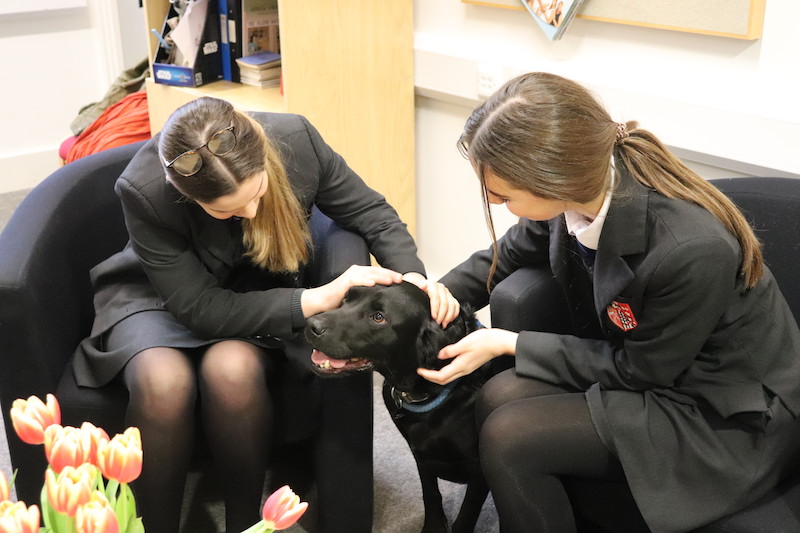Brentwood pupils given paws for thought
Posted on 3rd Feb 2020 in School News, Wellbeing
Pupils at Brentwood School haven’t gone barking mad….. three canine students really have joined the School roll! George, Henry and Harry made their campus debut today which just happens to be the start of Children’s Mental Health Week.
It is the first time in the School’s 463-year history that three new recruits haven’t had to worry about an ‘oversized’ new school uniform, a slightly too short start-of-term haircut and have immediately made themselves comfortable on the floor of the Headmaster’s Study!
George, a one-year-old Cavapoochon; Henry, a three-year-old Labrador, and five-year old English Bulldog, Harry, are Brentwood’s first wellbeing dogs and within minutes of passing through the School gates these new starters had already made hundreds and hundreds of new friends.
Student and staff wellbeing is a top priority at the Ingrave Road school and this new pooch programme is part of a comprehensive timetable of wellbeing events, workshops, talks and classes which will ensure Brentwood continues to lead the field.
Behind the scenes, George, Henry and Harry have been acclimatising to school life and strict rules have been put in place to ensure their safety and happiness, with pupils being urged to ‘treat the wellbeing dogs the way they would like to be treated.’
Headmaster Michael Bond, who will be sharing his study with George every Tuesday, said he was delighted to launch the initiative: “There is increasing research into the beneficial effects of working with animals from the perspective of wellbeing and positive mental health.
“Many schools, hospitals and retirement homes have, for some time now, used wellbeing dogs to help children, patients and the elderly relax and de-stress. Wellbeing dogs can be used as a source of comfort and relaxation for pupils who need a little bit of breathing space away from the usual school backdrop.
“This initiative was introduced by a group of Lower Sixth students who felt that pupil wellbeing would be augmented by having a wellbeing dog in our midst. The proposal was then ratified by the Health and Safety Committee and we have researched, risk- assessed, discussed the practicalities and agreed that a limited number of staff-owned dogs will be allowed onto the School site – all with the appropriate temperament and with experience of children.”
Needless to say children who do not want to have contact with the dogs, perhaps due to allergies, would not do so and all those who want to spend time with their new school chums will be supervised at all times.
Mr James Brown, Non Executive Director at Mental Health First Aid England, said: “This is an excellent initiative which involves a wellbeing approach fully endorsed by MHFA. Congratulations to all involved.”
Interaction with wellbeing dogs has been shown to increase exercise, boost confidence and even reduce blood pressure. Other benefits include:
● Cognitive – companionship with a dog stimulates memory, problem-solving and game-playing
● Social – a dog provides a positive mutual topic for discussion, encourages responsibility, wellbeing and focused interaction with others
● Emotional – a school dog improves self-esteem, acceptance from others and lifts mood, often provoking laughter and fun. Dogs can also teach compassion and respect for other living things as well as relieving anxiety
● Physical – interaction with a furry friend reduces blood pressure, provides tactile stimulation, assists with pain management, gives motivation to move and walk and stimulates the senses
● Environmental – a dog in a school increases the sense of a family environment, with all of the above benefits continuing long after the school day is over
● Reading – reading to dogs has been proven to help children develop literacy skills and build confidence, through both the calming effect the dog’s presence has on children as well as the fact that a dog will listen to children read without being judgemental or critical. This comforting environment helps to nurture children’s enthusiasm for reading and provides them with the confidence to read aloud.